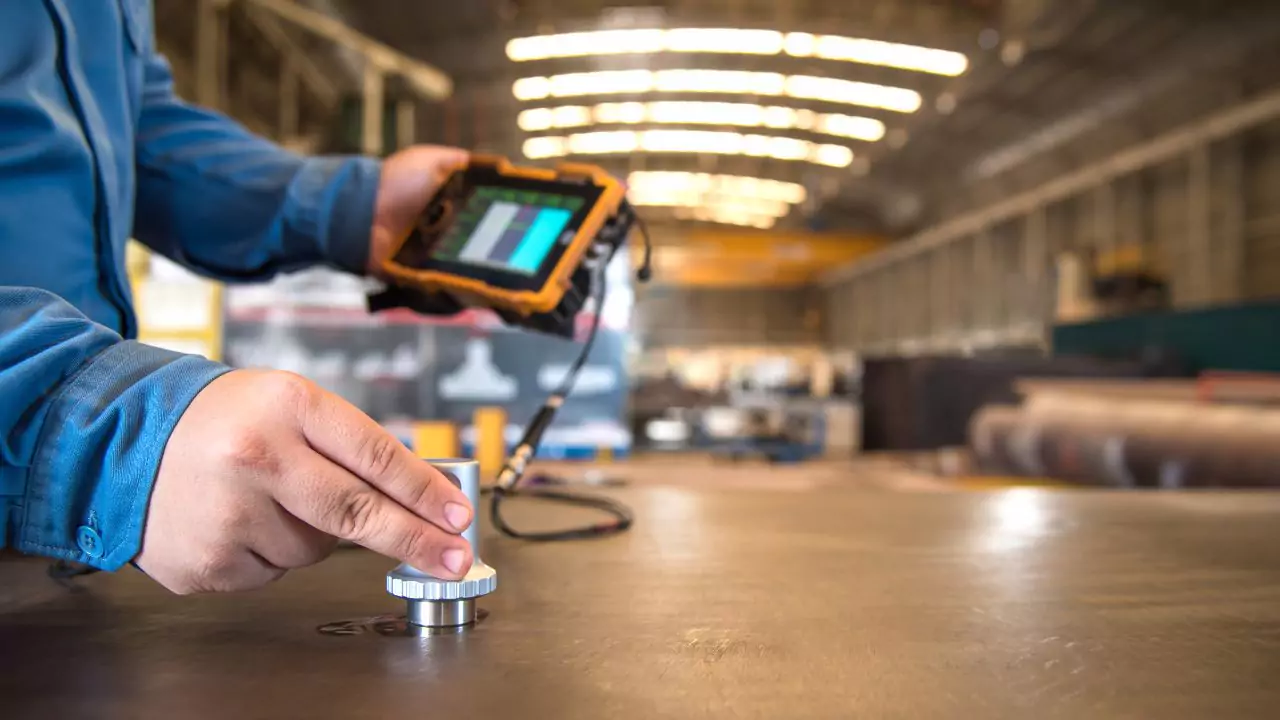Ultrasonic testing (UT) includes a variety of non-destructive testing (NDT) techniques, where sound waves are transmitted into an object or material. These high frequency sound waves are transmitted into materials to characterise the material or look for flaws.
A typical UT inspection application is ultrasonic thickness measurement. This is used to determine how thick an object is, such as measuring the corrosion to pipework.

How does Ultrasonic Testing work?
Ultrasonic inspection relies on a piezoelectric transducer connected to a flaw detector which, in its simplest form, is a pulser-receiver and an oscilloscope display. The transducer is passed over the object being inspected, usually coupled to the test object using gel, oil or water.
The couplant is necessary for transferring the sound energy from the transducer into the part, however couplant is not required when performing tests of contact-free techniques such as electromagnetic acoustic transducer (EMAT) or using laser to excite.
Pulse-echo & Through-Transmission
Ultrasonic testing can be done through 2 basic methods – pulse-echo and through-transmission.
When doing pulse echo testing the transducer both sends and receives the sound wave energy. This method utilizes echo signals at an interface (back of the object or a flaw) to bounce sound waves back to the probe.
So when you look at the outcomes, you can see it is a line plot where the y-axis has an amplitude that represents how intense the reflection is while the x-axis either has distance or time related to the depth of the signal as it travelled through the material.
Through-transmission testing uses an emitter to send the ultrasound waves out from one surface, and a separate receiver to pick up the sound energy that made it to the opposite side of the object. By detecting the location of any reduction in sound in the received signal, we can find imperfections.
Contact, and immersion testing.
Ultrasonic testing can be further broken down into 2 main types; contact or immersion testing.
Contact ultrasonic testing is generally performed for onsite inspections because it is accessible or portable.
Contact ultrasonic inspection can be completed under scenarios where only one side of a test specimen is visible, or where the parts to be inspected are large, irregular shape or simply difficult to transport.
Immersion ultrasonic testing is laboratory or factory based non-destructive test procedure which is best suited to curved components, complex geometries, and ultrasonic technique development.
In immersion, the component or material is submerged in a bath of water, which acts as the couplant in place of the gels used in contact ultrasound.
Immersion UT generally uses the pulse-echo method, and robotic probe trajectories can be used to investigate complex surfaces which would be difficult to cover with contact probes.
Because immersion UT can be used on a variety of wall thicknesses (and many material types) it is a well suited testing method for multiple applications and industries.
Why Is Ultrasonic Testing Used?
Ultrasonic testing is a non-destructive testing technique, so it allows for detecting flaws and defects without damaging the object or material being tested.
Periodic ultrasonics inspections may also allow for the identification of corrosion or the growth of known defects, practically preventing part, component, or entire asset failure.
It is used in a variety of industries, including aerospace, automotive, civil engineering, construction, medical, metallurgy, and manufacturing.
What Materials Can Be Tested?
Ultrasonic testing is used in many industries because of its applicability to many different types of materials. UT is most commonly used to inspect dense, crystalline structures found in metals.
Ceramics, plastics, composites and concrete can also be inspected although other types of defects and features like porosity may be more difficult to detect because of the reduced resolution and higher attenuation of the sound waves.
Ultrasonic technology has been effectively used in the medical industry for many decades, and it is increasingly becoming the preferred diagnostic imaging and research imaging method because of the absence of ionising radiation.
Benefits of Ultrasonic Testing
The benefits of ultrasonic testing include:
- High penetration power, making it possible to find flaws deep within a part
- High sensitivity, making it possible to find very small flaws
- Can be used to inspect materials with access from only one side
- Generally more precise than other non-destructive testing tools for assessing depth of internal flaws and for assessing thickness of parts with parallel surfaces
- Can make assessments about the size, shape, orientation and nature of defects
- Can make assessments of alloy structures of components with differing acoustic characteristics
- Non-hazardous for to nearby people, equipment and materials
- Highly automated and portable assessments possible
- Obtain results immediately, allowing for immediate decisions to be made
Limitations of Ultrasonic Testing
However, there are some limitations to ultrasonic testing as follows:
- Need experienced technicians for inspection and interpretation of data
- False positives, or spurious signals, may be caused from either acceptable anomalies or due to the component geometry
- Objects that are rough, irregularly shaped, a thin size or dimension, or not homogeneous are hard to inspect
- Loose scale or paint must be removed prior to inspection, although clean and properly bonded paint can remain on the surface
- Couplants are needed for any tests which use conventional UT
- UT may have less sensitivity for volumetric flaws, particularly metal inclusions, than radiography
Applications of Ultrasonic Testing
Ultrasonic testing has many applications across industry including the testing of the integrity of a material or component. This would include the testing of welds to assess for any discontinuities.
A wide range of materials can be utilized in ultrasonic testing to include both ferrous and non-ferrous materials as well as for thicker sections and those accessible from one side.
UT will also be able to detect finer defects and planar flaws that may not be detectable as readily through radiographic testing.
Applications for UT are found in aerospace, automotive, construction, rail, medical and oil and gas industries.